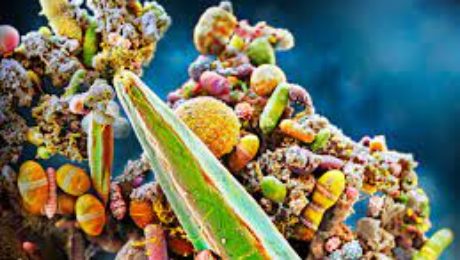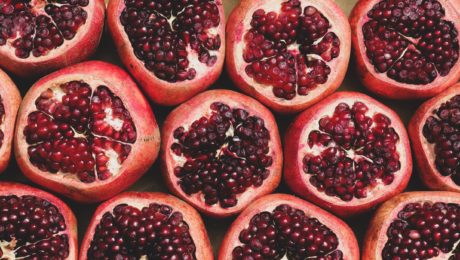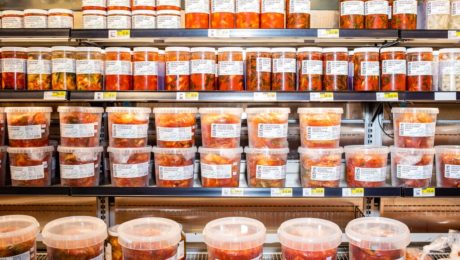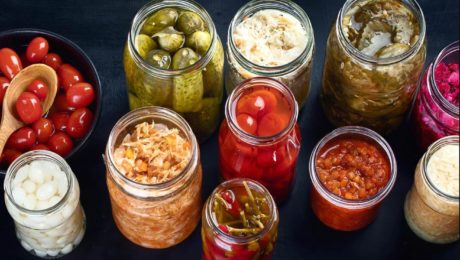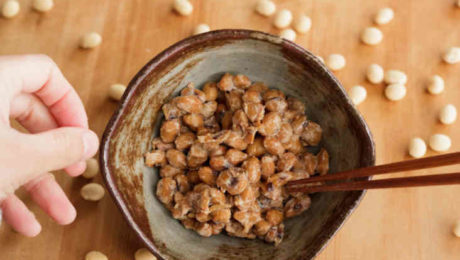The Stickier the Natto, the Better
Natto significantly lowers levels of both glucose and insulin, according to research by Japan’s National Agriculture and Food Research Organization. Natto, a traditional food in Japan, is a fermented soybean dish valued for its high-nutrient content. It’s characterized by sticky strands that stretch from the dish when stirred and, the research showed, stickier natto is healthier.
Natto’s stringy texture is produced by y-polyglutamic acid (y-PGA), and stickier natto has higher levels of y-PGA. When nondiabetic men and women were fed a series of meals of both high-and low-y-PGA natto, high y-PGA natto “significantly” lowered glucose and insulin levels in the test subjects.
Study results were published in the scientific journal Nutrients. Researchers next hope to “study the long-term health impacts of a diet that includes high γ-PGA natto.”
Read more (Chemical & Engineering News)
Can Gut Microbes Fight Viruses?
An estimated 40 trillion microbes make up our gut microbiome. Researchers are now studying how these microbes protect our immune system, fighting off viruses like Covid-19.
“Imagine microbes that block a virus from entering a cell or communicate with the cell and make it a less desirable place for the virus to set up residence,” says Mark Kaplan, chair of the department of microbiology and immunology at the Indiana University School of Medicine. “Manipulating those lines of communication might give us an arsenal to help your body fight the virus more effectively.”
These microbes, according to an article in National Geographic, may fight viruses in one of three ways: “building a wall that blocks invaders, deploying advanced weaponry and providing support to the immune system.” Kaplan calls intestinal bacteria “the gatekeepers between what we eat and our body.”
The article details the new, innovative measures medical professionals are taking to repair a patient’s damaged gut microbiome — transplanting fecal matter, administering a bacteria-targeting virus and pills that release antiviral interferons. But the most compelling way may be consuming a diet rich in fermented foods — the article notes a consensus among medical and science professionals that fermented foods can promote a healthy microbiome.
Read more (National Geographic)
Is Fermented Pomegranate New Skincare Holy Grail?
Researchers think fermented pomegranate could be the latest anti-aging secret. A study published in the Journal of Cosmetic Dermatology found patients who drank fermented pomegranate (FPE) or used it as a serum improved their skin quality.
In the double-blind study, participants who drank FPE saw increases in their skin’s moisture, brightness, elasticity and collagen density after 8 weeks. Participants who used FPE serum noticed the same skin improvements — plus a reduction of UV spots.
The study concludes that fermented pomegranate extracts, when consumed daily, “can protect the skin against oxidative stress and slow skin aging.
Read more (Dermatology Times)
Fermented Foods FAQ
The New York Times breaks down “The Dos and Don’ts of Fermented Foods” in a new article. Food science writer, Anahad O’Connor, was interviewed to answer some of the most frequently asked questions about fermented foods. For example: What are the differences in sugar content of yogurt brands? How can fermented foods be incorporated into daily life?
O’Connor says there are “thousands of different types of fermented foods consumed around the world” that “are chock-full of live microorganisms, known as probiotics, and they are widely available at grocery stores, supermarkets and farmers’ markets.”
He shared his advice for shopping for fermented foods, pointing out: “Not all foods that are made through fermentation contain live microorganisms when they reach store shelves or your kitchen table.” Sourdough, for example, loses all fermented bacteria once baked. Most wine is filtered and processed to make any live microbes disappear. Fermented foods packaged with statements like “containers probiotics,” “contains live cultures” or “naturally fermented” are good products to look for — and most are in the refrigerated aisles.
Read more (The New York Times)
- Published in Health
TFA Fermentation News Goes Mainstream
Three weeks ago, The Fermentation Association shared results of a Stanford study that found fermented foods improve health. Numerous media outlets picked up on the study results, too, and now The New York Times has shared them as well, reporting: “Now scientists are discovering that fermented foods may have intriguing effects on our gut. Eating these foods may alter the makeup of the trillions of bacteria, viruses and fungi that inhabit our intestinal tracts, collectively known as the gut microbiome. They may also lead to lower levels of body-wide inflammation, which scientists increasingly link to a range of diseases tied to aging.”
The Times article pointed out that the study results challenge the long-held belief that fiber-rich foods are good for the gut. A high-fiber diet instead showed little impact on the makeup of the gut microbiome. In fact, study participants who “had the least microbial diversity had slight increases in inflammation when they ate more fiber…” suggesting they lacked the microbes to digest the amount of fiber consumed.
Meanwhile, the participants that consumed a diet high in fermented foods had a greater number of microbial species develop in their gut. And only 5% of those new microbes were directly from the fermented foods they ate. “The vast majority came from somewhere else, and we don’t know where,” says Justin Sonnenburg, an author of the new study and a professor of microbiology and immunology at Stanford.
Read more (The New York Times)
Highlights from TFA’s Member Survey
The Fermentation Association recently surveyed our community to better understand who has engaged with us, how their businesses are doing and to gauge the impact of the pandemic. We want to share the very interesting results.
A few qualifying comments first, however. This survey should not be interpreted as producing a profile of the fermented industry — it reached only those with whom we have connected since TFA was launched in 2017. This group is heavily weighted to Food and Beverage Producers and those in the Science, Health and Research fields. And, even as we note surprisingly high response rates below, the quantities of responses to certain questions were small and would not meet standard analytical thresholds of statistical significance. So please treat the comments and conclusions that follow as directional rather than definitive.
We received 450 full or partial responses — nearly twice the number we had expected and what we would have considered “good.” Not surprisingly, the bulk of these were from Food and Beverage Producers — just under half — with a strong representation of the Science, Health and Research community, a little less than one-fifth. The balance of the respondents were classified as Supplier or Service Provider (9%); Chef/Writer/Educator (8%); Retailer/Distributor/Broker (3%); Food Service/Hospitality (3%); or fell into a miscellaneous Other category (12%).
We will be presenting further analyses and follow-up discussions in the coming weeks. This article focuses on the two largest segments: first, Food & Beverage Producers; then, Science, Health, and Research.
FOOD & BEVERAGE PRODUCERS
- We found that over 80% of our Producers are small businesses with 25 or fewer employees, and 65% had 2020 sales of less than $500,000. That said, over 11% of the companies represented are toward the other end of the spectrum, with 100 or more on staff, and 13% with revenue of over $10 million.
- We reach a lot of Owners/Founders/Senior Executives, over 70% of respondents. The next most well-represented functional areas are Operations and Product Development.
- These businesses are spread across the developmental timeline — a little over 40% are selling at the local level, or earlier in their growth cycle (selling at farmers market or still in testing/pre-launch mode). Yet 45% are selling regionally, nationally or internationally.
- Retail is still the largest (45%) channel of sale for these producers, but Direct-to-Consumer (DTC) is just slightly behind at 40%, with the remaining 15% through Food Service/Hospitality.
- Sauerkraut/Kimchi, Pickles, Condiments/Sauces and Kombucha were the most frequently-listed product categories, each mentioned by more than 20% of the producers. Kefir, Vinegar/Shrubs, Wine and Miso also were mentioned often. Of the 25 product categories listed, we had respondents involved in every one — except poor, slimy, and unrepresented natto.
- Nearly half of producers selling at retail and/or DTC had sales gains in 2020 and another third maintained their revenues. Not surprisingly, nearly 40% of producers selling into food service saw sales take a hit — only 15% reported gains.
- The Covid-19 pandemic caused a host of issues for producers, though their prevalence seemed to vary depending on the size of the company. Among larger producers, over 90% had issues meeting demand, with the primary problems being shortages of raw materials, packaging and staff, as well as distribution delays. Fewer of the small producers reported issues, but their problems fell into the same categories. Financial difficulties were cited more often among small producers.
- Nearly 30% of producers took advantage of the government’s Payroll Protection Plan.
- This year appears to continue or build on the sales levels achieved in 2020 for most producers. Nearly 40% report first quarter 2021 sales at the same level as last year, and nearly 50% reported further increases. And producers are optimistic about continuing these trends, with a mere 5% anticipating sales declines.
- Most (nearly two-thirds) of responding producers did not participate in tradeshows and conferences, and therefore felt no business impact from show cancellations in 2020.
- The producers that did participate in events favored the Natural Products Expos, Fancy Food Shows and IFT Show. While some felt that they lost short-terms sales and their future growth was hurt by the shows being cancelled, nearly 30% noted that they saved money and time by not attending. Some of those savings were reinvested in increased marketing, DTC sales and virtual events.
- Interestingly, half of the producers plan to continue their involvement as events resume at the same level as before the pandemic, and fully one-third plan to increase activity.
- Looking ahead, producers see numerous challenges on the horizon, led by a need for expanded distribution. They expect many of the recent shortages to continue to challenge, compounded by production, facility and financial constraints. While Covid protocols and food safety concerns persist, they are joined by the need for product development, e-commerce skills, and consumer marketing
- The clearly-articulated top priority for producers is a better-educated consumer. When asked what would foster increased consumption of fermented foods and beverages, the top item for nearly 70% is consumer education as to the nature and benefits of fermentation. The next highest priorities all support this same goal — more research into health impact (+40%), greater familiarity with flavors of fermentation (+40%) and more exposure at retail (+30%).
SCIENCE, HEALTH & RESEARCH
- The bulk — nearly 75% — of these respondents work in an academic environment, with very small clusters in government and medical/health organizations. It’s a well-educated group, with over half holding doctorates, plus another quarter with Master’s degrees. Roles are split quite evenly into thirds — professors, science/technical support and students/postdocs.
- Over 60% of these respondents are looking into connections between fermentation and health; roughly half are specifically focused on gut health and the human microbiome. Overall, three-quarters are currently researching fermentation and fermented products. Their activities, though, span the full spectrum of product categories. All the key categories among our producers — Sauerkraut/Kimchi, Pickles, Condiments/Sauces, Kombucha and Kefir — were well-represented in research. But they were joined by meaningful work across the board — Yogurt, Beer, Cheese, Alternative Proteins, Koji, Wine, Sourdough, Tempeh, Tea — even Natto!
- Slightly more than a third of this group is involved with fermented alternative proteins – an important, emerging category.
- Funding for research showed more declines (30% of respondents) than gains (under 15%) over the last year. But half of our sample expects funding to increase in the coming 12-18 month.
- Our Science, Health & Research respondents were split in how they viewed the interest in fermentation research — 60% felt the focus was increasing, but the topic was not yet a top priority. Yet a third saw fermentation as a hot topic, with more emphasis and activity than ever.
- Respondents in this group shared the views of producers that the key activities that would drive increased consumption of fermented products are:
- Consumer education about fermentation
- More research into health benefits
- Greater consumer familiarity with fermented flavors
- Published in Business, Food & Flavor, Health, Science
Fermentation vs. Fiber — Both Help, but Fermentation Shines
A diet high in fermented foods increases microbiome diversity, lowers inflammation, and improves immune response, according to researchers at Stanford University’s School of Medicine.The groundbreaking results were published in the journal Cell.
In the clinical trial, healthy individuals were fed for 10 weeks, a diet either high in fermented foods and beverages or high in fiber. The fermented diet — which included yogurt, kefir, cottage cheese, kimchi, kombucha, fermented veggies and fermented veggie broth — led to an increase in overall microbial diversity, with stronger effects from larger servings.
“This is a stunning finding,” says Justin Sonnenburg, PhD, an associate professor of microbiology and immunology at Stanford. “It provides one of the first examples of how a simple change in diet can reproducibly remodel the microbiota across a cohort of healthy adults.”
Researchers were particularly pleased to see participants in the fermented foods diet showed less activation in four types of immune cells. There was a decrease in the levels of 19 inflammatory proteins, including interleukin 6, which is linked to rheumatoid arthritis, Type 2 diabetes and chronic stress.
“Microbiota-targeted diets can change immune status, providing a promising avenue for decreasing inflammation in healthy adults,” says Christopher Gardner, PhD, the Rehnborg Farquhar Professor and director of nutrition studies at the Stanford Prevention Research Center. “This finding was consistent across all participants in the study who were assigned to the higher fermented food group.”
Microbiota Stability vs. Diversity
Continues a press release from Stanford Medicine News Center: By contrast, none of the 19 inflammatory proteins decreased in participants assigned to a high-fiber diet rich in legumes, seeds, whole grains, nuts, vegetables and fruits. On average, the diversity of their gut microbes also remained stable.
“We expected high fiber to have a more universally beneficial effect and increase microbiota diversity,” said Erica Sonnenburg, PhD, a senior research scientist at Stanford in basic life sciences, microbiology and immunology. “The data suggest that increased fiber intake alone over a short time period is insufficient to increase microbiota diversity.”
Justin and Erica Sonnenburg and Christopher Gardner are co-authors of the study. The lead authors are Hannah Wastyk, a PhD student in bioengineering, and former postdoctoral scholar Gabriela Fragiadakis, PhD, now an assistant professor of medicine at UC-San Francisco.
A wide body of evidence has demonstrated that diet shapes the gut microbiome which, in turn, can affect the immune system and overall health. According to Gardner, low microbiome diversity has been linked to obesity and diabetes.
“We wanted to conduct a proof-of-concept study that could test whether microbiota-targeted food could be an avenue for combatting the overwhelming rise in chronic inflammatory diseases,” Gardner said.
The researchers focused on fiber and fermented foods due to previous reports of their potential health benefits. High-fiber diets have been associated with lower rates of mortality. Fermented foods are thought to help with weight maintenance and may decrease the risk of diabetes, cancer and cardiovascular disease.
The researchers analyzed blood and stool samples collected during a three-week pre-trial period, the 10 weeks of the diet, and a four-week period after the diet when the participants ate as they chose.
The findings paint a nuanced picture of the influence of diet on gut microbes and immune status. Those who increased their consumption of fermented foods showed effects consistent with prior research showing that short-term changes in diet can rapidly alter the gut microbiome. The limited changes in the microbiome for the high-fiber group dovetailed with previous reports of the resilience of the human microbiome over short time periods.
Designing a suite of dietary and microbial strategies
The results also showed that greater fiber intake led to more carbohydrates in stool samples, pointing to incomplete fiber degradation by gut microbes. These findings are consistent with research suggesting that the microbiome of a person living in the industrialized world is depleted of fiber-degrading microbes.
“It is possible that a longer intervention would have allowed for the microbiota to adequately adapt to the increase in fiber consumption,” Erica Sonnenburg said. “Alternatively, the deliberate introduction of fiber-consuming microbes may be required to increase the microbiota’s capacity to break down the carbohydrates.”
In addition to exploring these possibilities, the researchers plan to conduct studies in mice to investigate the molecular mechanisms by which diets alter the microbiome and reduce inflammatory proteins. They also aim to test whether high-fiber and fermented foods synergize to influence the microbiome and immune system of humans. Another goal is to examine whether the consumption of fermented foods decreases inflammation or improves other health markers in patients with immunological and metabolic diseases, in pregnant women, or in older individuals.
“There are many more ways to target the microbiome with food and supplements, and we hope to continue to investigate how different diets, probiotics and prebiotics impact the microbiome and health in different groups,” Justin Sonnenburg said.
Other Stanford co-authors are Dalia Perelman, health educator; former graduate students Dylan Dahan, PhD, and Carlos Gonzalez, PhD; graduate student Bryan Merrill; former research assistant Madeline Topf; postdoctoral scholars William Van Treuren, PhD, and Shuo Han, PhD; Jennifer Robinson, PhD, administrative director of the Community Health and Prevention Research Master’s Program and program manager of the Nutrition Studies Group; and Joshua Elias, PhD.
Researchers from the nonprofit research center Chan-Zuckerberg Biohub also contributed to the study. Here’s the complete press release from Stanford Medicine News Center.
Natto Stops Covid-19?
Natto — the sticky, slimy fermented soybeans, commonly eaten in Japan — inhibits infection by the coronavirus, according to the Tokyo University of Agriculture and Technology (TUAT). Researchers found that natto contains extracts that break down proteins on the surface of the coronavirus, preventing it from infecting cells.
Their results, published in the journal Biochemical and Biophysical Research Communications, note further studies are needed to determine if there are antiviral properties in the food. But the trial found natto also limited infection by Bovine herpesvirus-1 (BHV-1), a cause of outbreaks of respiratory disease in cattle around the world.
Important to note: the study was funded by Takano Foods Co., Ltd., a Japanese company that makes natto commercially.
Read more (Biochemical and Biophysical Research Communications)
Which Are Healthier — Fermented or Acidified Pickles?
Researchers with the USDA have found that fermented cucumber pickles contain more of the naturally-occurring gamma-aminobutyric acid (GABA) than do their acidified counterparts. Results of this study of commercially-available pickles were recently published in the Journal of Food Composition and Analysis.
GABA works as a neurotransmitter in the brain. It has been scientifically proven that GABA, when consumed in foods or supplements, reduces blood pressure, improves decision making, reduces anxiety and boosts immunity.
Fermented cucumber pickles undergo a lactic acid fermentation, whereas acidified cucumber pickles are submerged in an acidic brine. The fermented pickles with the most GABA were made in a low-salt fermentation, and the products were prepared for direct consumption. GABA content also was found to remain stable during storage for fermented cucumbers.
“Worldwide, people are interested in consuming fermented foods as part of a healthy lifestyle. Most often, we associate the healthfulness of fermented foods with probiotic microbes. But many fermented foods contain few to no microbes when consumed,” said Jennifer Fideler Moore, North Carolina State University graduate research assistant and one of the study co-authors, in a USDA-ARS press release. “Our research shows that the health-promoting potential of lactic acid fermented cucumbers reaches far beyond the world of probiotics. This opens the door to more research into health-promoting compounds made during fermentation of fruits and vegetables.”
Adds Suzanne Johanningsmeier, study co-author and USDA Agricultural Research Service (USDA-ARS) Research Food Technologist: “Fruits and vegetables are made up of thousands of unique molecules. These molecules rule the flavor, texture, and nutritional value, but it is difficult to study them in such complex systems. To tackle this problem, we use advanced analytical chemistry techniques like mass spectrometry to study food molecules and figure out the best food processing methods for improved quality of fruit and vegetable products.”
[Johanningsmeier presented further details of the study during a TFA webinar.]A New Breed of Animal-Free Milk
Can you imagine dairy-free milk without a nut or oat? An Israeli start-up is using precision fermentation to create animal-free milk “indistinguishable from the real thing.”
Imagindairy’s technology recreates the whey and casein proteins found in a mammal’s milk. The fermentation time is quick at 3-5 days, and the final product mimics the taste and texture of traditional dairy milk, without cholesterol or GMOs. The product is expected to be in stores in the next two years.
“Many food products are produced in fermentation, including enzymes, probiotics and proteins,” says Eyal Afergan, co-founder and CEO of Imagindairy. He emphasized how safe the product is. “In fact, on the contrary, fermentation process produces a cleaner product which is antibiotic free and reduces the exposure to a potential milk borne pathogens.”
Read more (Food Navigator)


